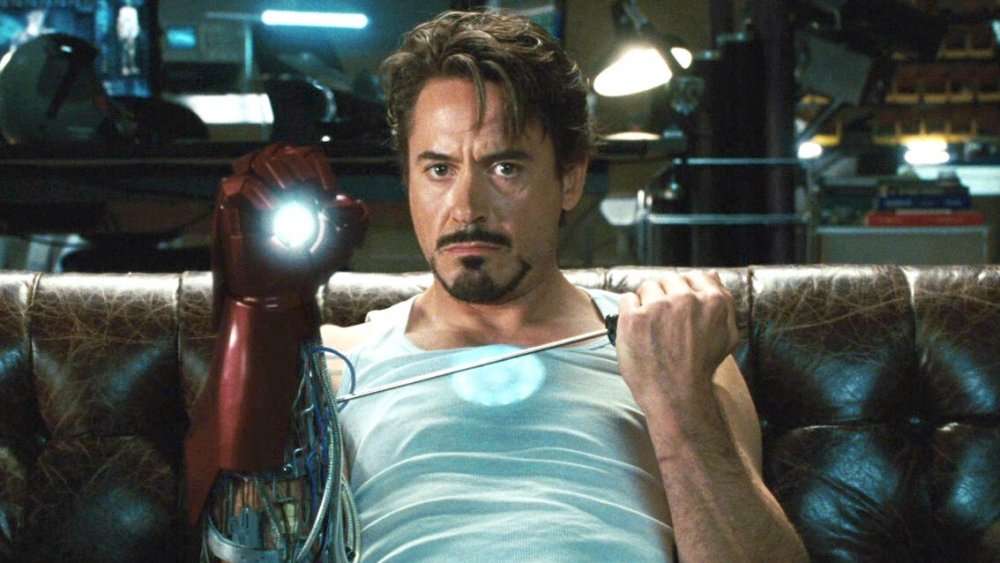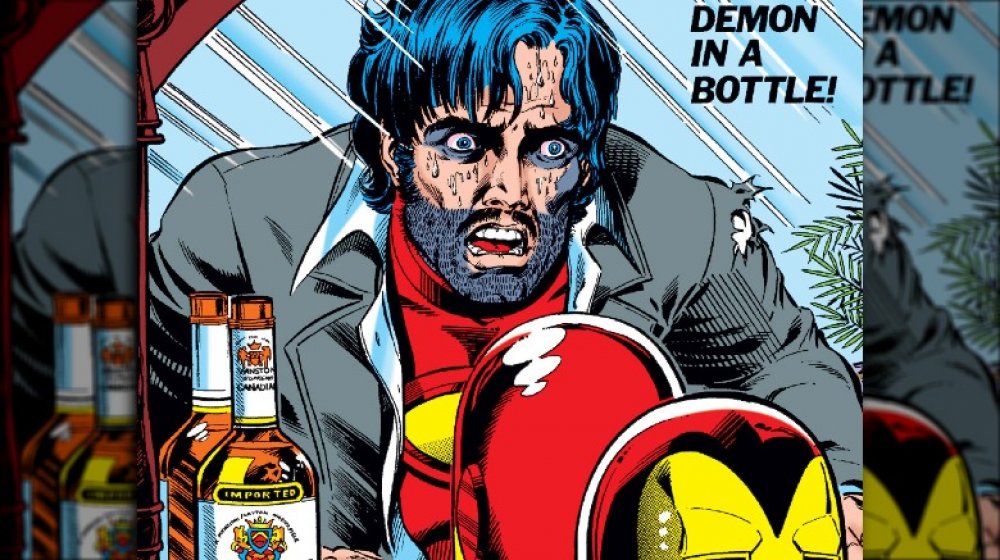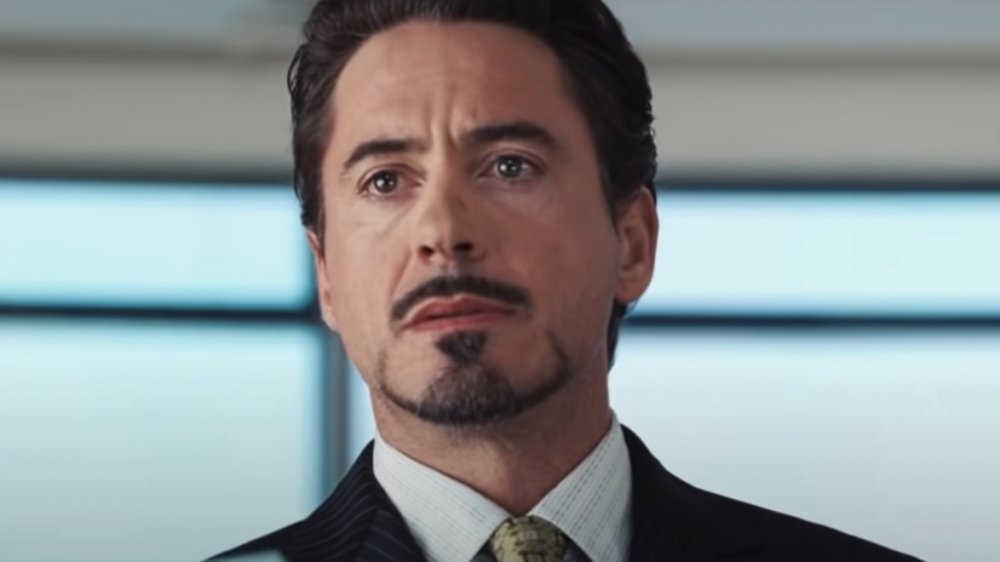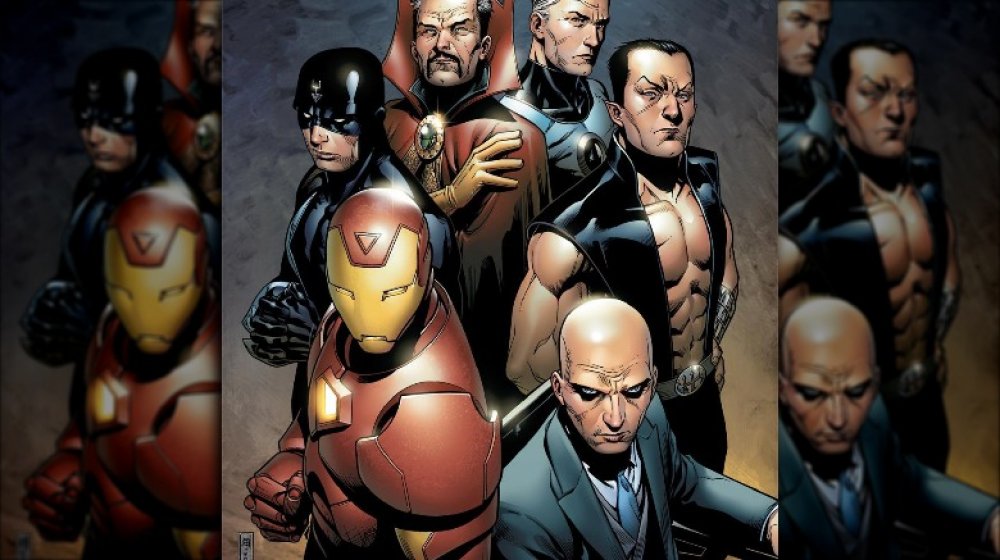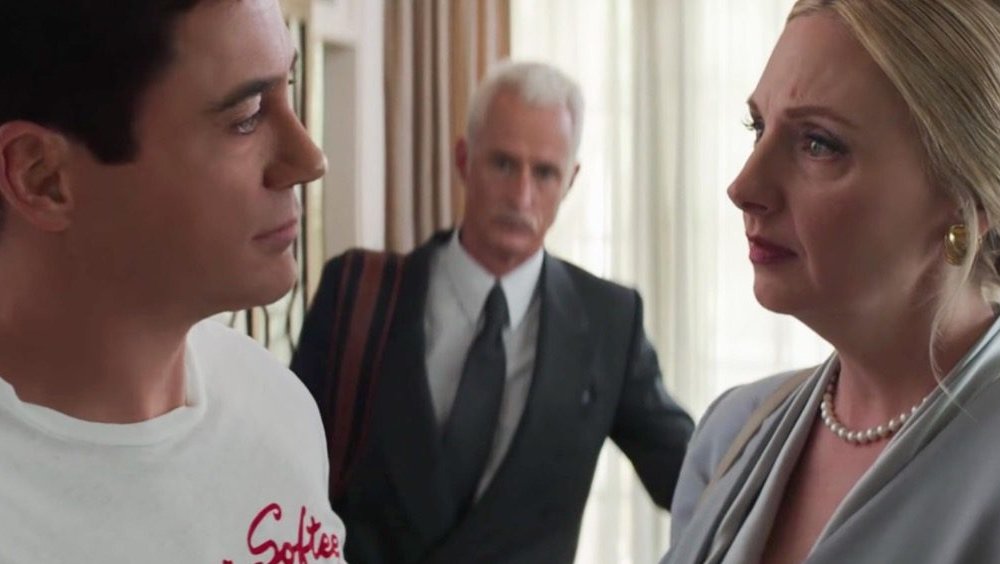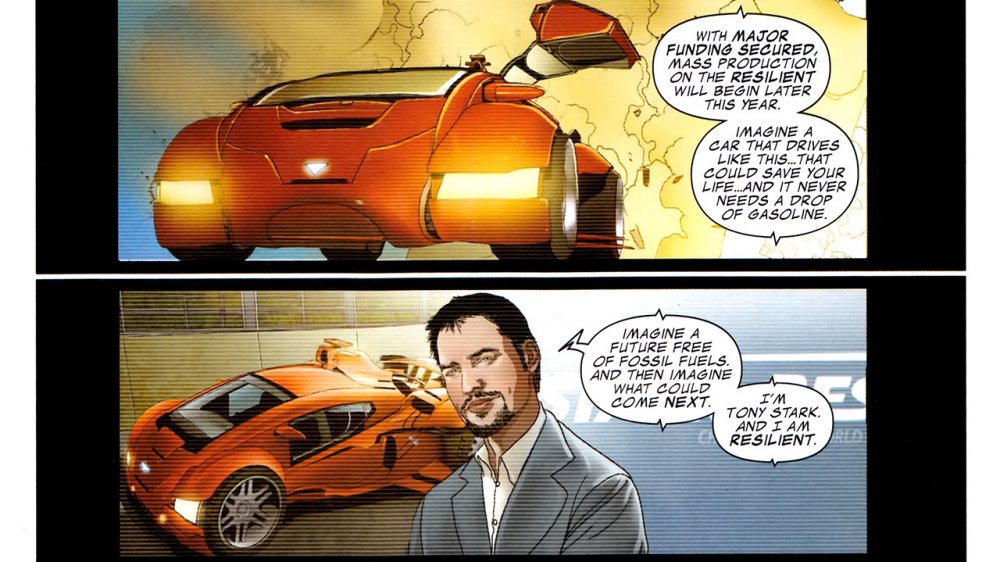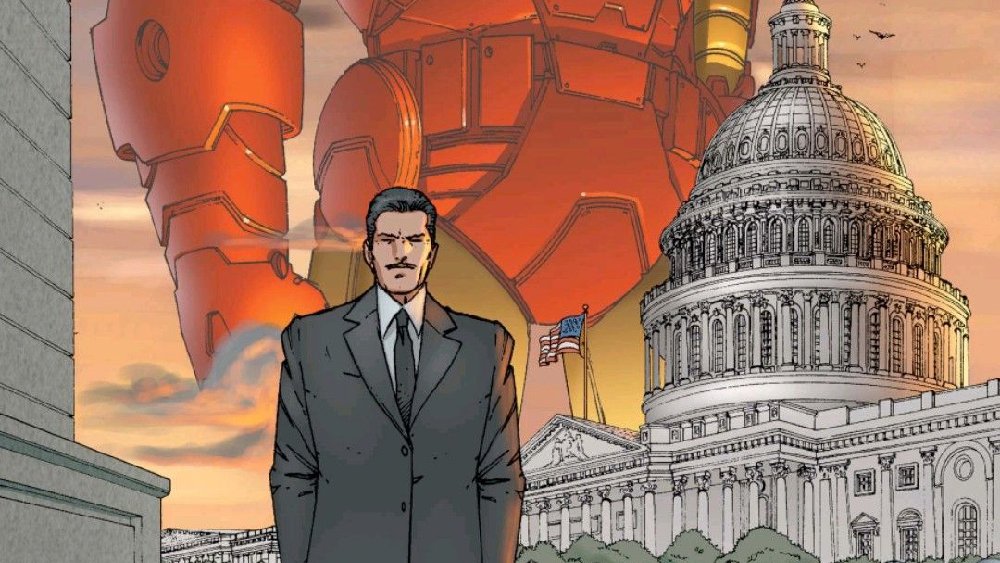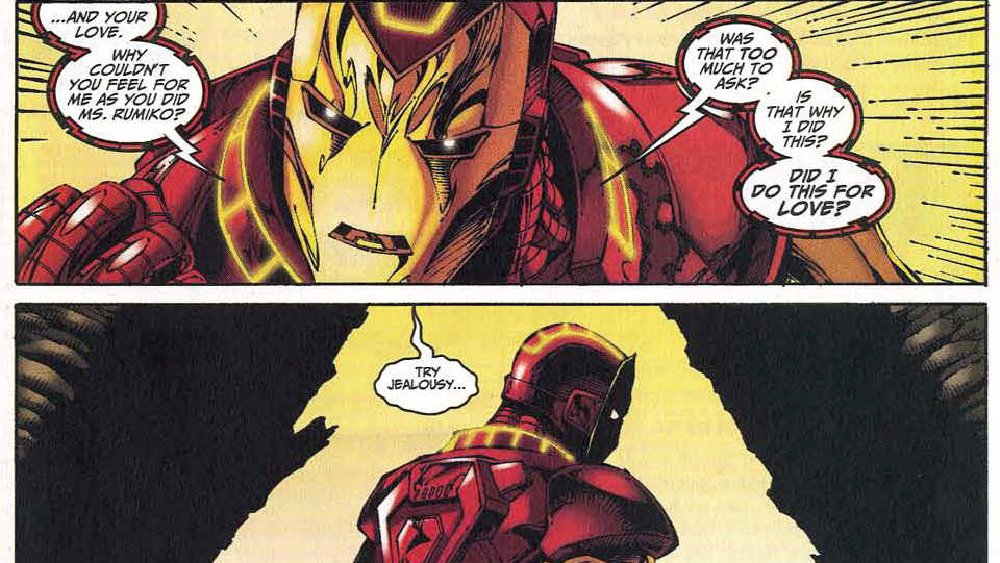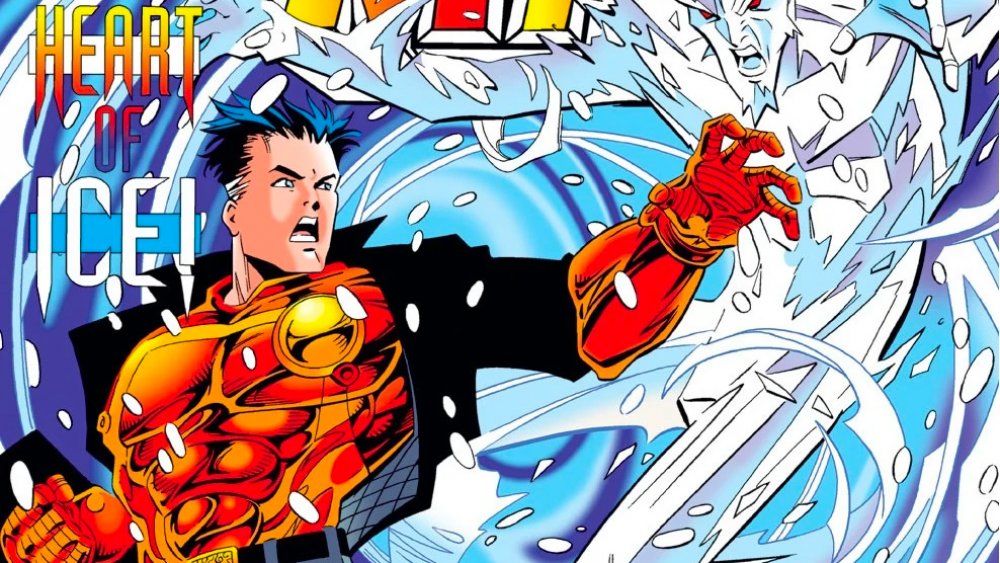Things About Iron Man That Didn't Make It Into The MCU
The Marvel Cinematic Universe might've been spread out over a decade of films that starred more superheroes than you can shake an Infinity Gauntlet at, but when you get right down to it, it's really the story of Tony Stark. He was the character who launched the whole thing back in 2008, and the surprising blockbuster success of the first Iron Man movie helped to elevate him from being everyone's third-favorite Avenger to the kind of character that you could build a 24-movie franchise around. It made Tony Stark a (Tony) star, and it did it by giving moviegoers an almost perfect translation of what made Iron Man so compelling in the comics.
The precarious balance of brilliance and hubris, the guilt over his past and the desire to do something better, and even his tendency to be a guy that you hate to agree with, it's all there, forming the core of the character. That said, Iron Man has been kicking around the Marvel Universe for a very long time, and over the past six decades, the character's core has been wrapped up in some pretty complicated stuff that was left out of the films. From character-defining arcs to the sheer weirdness of the '90s, here are the things about Iron Man that just didn't make it to the MCU.
Where's the 'Demon in a Bottle' storyline?
One of the most surprising things about the cinematic version of Iron Man is that the MCU never adapted "Demon in a Bottle," the story that's pretty much defined Tony Stark as a character since it was originally published in 1979. If you know one thing about the comics version of Iron Man beyond "rich guy," "wears armor" and "has a mustache," it's this story, but in case you're not familiar with it, here's the short version. As the name implies, this is the one where Tony deals with his alcoholism and its consequences, even being kicked out of the Avengers before he's finally forced to confront it and go into recovery.
In the years since, Tony's struggles with addiction and his occasional relapses have been an intrinsic part of his ongoing story, and despite its age, "Demon in a Bottle" itself has been praised as one of the best comics to ever mix superheroic action with important real-life issues. Tony has even been a central figure in helping other characters deal with their own similar issues — most notably Carol Danvers, who's also portrayed as recovering alcoholic.
Of course, while it's not explored with the depth and consistency that we see in the comics, Tony's drinking problem is pretty heavily alluded to in Iron Man 2, with the scene where he gets drunk and winds up tearing up his own living room in a super-powered fistfight with War Machine. That's it, though, and the fact that such a humanizing, relatable, and important aspect of his character is only mentioned briefly is surprising, especially when you consider that other issues like PTSD are central to the plots of Iron Man 3, Avengers: Age of Ultron, and even Captain America: Civil War. It's a pretty big deal, and making three Iron Man movies and another five or six where he's a central character without getting into it is kind of like making a Superman movie where nobody ever mentions he can fly.
Iron Man's secret identities
The defining moment of the first Iron Man movie — which ends up being one of the definitive moments of the entire MCU — comes in its very last line, when Tony Stark publicly reveals that he's Iron Man. Not only does this help distinguish the Iron Man movies from films about Superman and Batman, where the duality of the heroic and civilian identities is often a pretty big theme, it works really well from a character standpoint. Tony's entire arc in that movie is wanting redemption for his past as an arms dealer. And owning up to both what he's done and what he's doing to make up for it fits right in with his character, especially since he's arrogant enough to want the credit for it. Also, as has been pointed out countless times over the years, the classic method for keeping Iron Man's identity secret by claiming that he's actually Tony Stark's bodyguard just doesn't make sense. It's hard to be someone's bodyguard when you're never actually seen together.
It does, however, mean that the MCU loses out on some of the stories that were built around Tony trying to keep his secret intact. After all, for years, the Tony of the comics stuck to the whole bodyguard lie. But why? Well, the official company line was that Iron Man was a test pilot who preferred to remain anonymous as to not attract the attention of Tony Stark's enemies. This reasoning falls apart when you consider that Tony Stark's enemies were going to be trying to kill both Tony Stark and Iron Man anyway, but it did lead to some pretty wild stories.
"Armor Wars" in particular features Tony going after anyone that he suspects of using his technology, leading him to put a serious beatdown on S.H.I.E.L.D. agents and part-time Avenger Stingray, and then avoiding any consequences by faking the death of "Randall Pierce," a completely fictional identity for Iron Man's pilot that he created through falsified documents. The weirdest thing about all that might be that the other Avengers completely bought it, even though the new Iron Man sounded like, acted like, and remembered everything that the "previous" guy did. This would've been pretty complicated to handle in the movies, but c'mon. Aren't you at least a little sad about not getting to see Robert Downey Jr. wearing a fake mustache over his real goatee and trying to put on a voice to fool Nick Fury?
The Illuminati didn't make it into the MCU
The Tony Stark of the MCU is a bit of a control freak. It's the throughline of his character from the original Iron Man all the way through to Endgame, as he makes one attempt after another to build a metaphorical (and sometimes literal) suit of armor around the world while events spiral into a cosmic level far beyond his control. The comics version of Tony is the same way — maybe even moreso.
In fact, he's so hellbent on controlling the world in an effort to make it safer that after the Marvel Universe gets its first big taste of the danger and conflict that exists beyond our planetary borders — the Kree-Skrull War — he gathers up a group of like-minded individuals to secretly guide the universe. The result is the Illuminati, a "team" of sorts that includes Tony, Reed Richards, Doctor Strange, Black Bolt of the Inhumans, and Namor. They also offer T'Challa, the Black Panther, membership in their secret cadre, but he refuses, knowing that this will only lead to bad things down the road.
And does it ever! While they do reap the benefits of sharing information with each other, the members of the Illuminati also make some pretty dubious decisions, including more than one attempt to gather up the Infinity Stones for themselves. The most notable error, though, is an attempt to "solve" the problem of having the Hulk around by just blasting him off into space and hoping it will work out for the best. Naturally, this leads to the Hulk returning, stronger and madder than ever, and beating the living crap out of the Illuminati for about six issues. Pretty amazing that the smartest people in the world didn't see that one coming.
Iron Man's daddy issues are way more complicated in the comics
One of the more surprising aspects of the MCU is how prominent Howard Stark is as a character. It's only pretty recently — post-MCU for the most part — that he's become even remotely a big deal in the comics, but he's all over the movies, helping to create Captain America, founding S.H.I.E.L.D., ticking off Ant-Man Sr., and hanging out with Peggy Carter in her solo adventures. Through all that, his connection to his son — or lack thereof, as he wasn't the most affectionate dad — has informed Tony's reaction to the people around him, from his problems with authority figures to his awkward attempts at mentoring Peter Parker.
With all the focus on Howard, though, the movies leave out the part where he's not actually Tony's biological father. To be fair, that's a pretty recent development, hitting the comics page in 2016, but it's definitely a big enough twist to bear mentioning. See, it turns out that Tony is actually the son of Jude, a S.H.I.E.L.D. agent who's actually a double-agent for HYDRA, and Amanda Armstrong, a S.H.I.E.L.D. agent who's also an indie singer-songwriter whose tours provided her with the cover for spy activities. When Amanda gets pregnant, Nick Fury decides to just drop the baby off at an orphanage in Bulgaria — apparently this was standard operating procedure for the spy organization, which raises a lot of questions — but Howard Stark finds out about it, and since he and his wife, Maria, are in the market for a kid at the time, he adopts li'l Tony and then keeps it a secret until he dies.
With that being the short version, you can see why this might've been a little too complicated for Howard to have mentioned when Tony ran into him on his time-travel trip in Endgame. That probably would've been enough time to mention that Tony also has a secret brother, though.
The MCU ignored the complex history of Stark Industries
Throughout Iron Man's appearances in the MCU, Tony Stark manages to retain complete control of his company while also spending a lot of time fighting killer robots and his jock friend's sketchy brother, which is a pretty impressive feat of entrepreneurship. The closest he comes to losing it is when he experiences an extremely hostile takeover, in which Obadiah Stane decides that building a giant wearable tank and murdering his boss would be a lot easier than, say, buying a controlling interest in the company.
In the comics, Tony hasn't been so lucky. For a character whose day job involves running a business, losing control of said business makes for a pretty easy source of drama, and that's a well that Marvel has returned to time and time again, with Stark going bankrupt and rebuilding his fortune with a clockwork regularity. It all starts when Stark Industries is taken over by Obadiah Stane, who, in this reality, tries buying up the company before he decides to go with armor murders. The company is renamed to Stane International, and Stark responds by moving to Los Angeles with a few still-loyal employees and founding a new company called Circuits Maximus. That, for the record, is up there with "Turner D. Century" as one of the worst puns in comics history.
After that, he founds Stark Enterprises, and when he's momentarily deceased, that's bought out by a Japanese company, becoming Stark-Fujikawa. After returning to life, he founds a consulting firm called Stark Solutions, which then becomes Stark Enterprises again, and when he loses control of that, he starts Stark Resilient to make electric cars, which then becomes Stark Industries again ... and then Stark Unlimited. Obviously, none of this would be very entertaining to watch on the screen — except the bits that involve dudes in giant metal clothes punching each other — but it would've been pretty interesting to see RDJ show up with a different logo on his T-shirt in every movie with zero explanation of why.
Iron Man's ties to the U.S. government
Tony Stark's comic book career isn't limited to the technological innovations of the private sector. He also occasionally works for the government — and not just as a defense contractor providing Uncle Sam with "Mandroid" armor and Helicarriers. After leading the pro-registration side of the comic book version of Civil War, Tony serves as the director of S.H.I.E.L.D., replacing Nick Fury after the super spy goes underground to pursue his own agenda.
Tony's tenure in that job isn't particularly long, and it ends when S.H.I.E.L.D. itself is replaced with a new organization called H.A.M.M.E.R., an acronym that doesn't actually stand for anything. Tony's spot as director goes to Norman Osborn. Yes, the guy who very publicly tries to kill Spider-Man while dressed up as a D&D monster. He gets the job because he fought an alien on TV. Listen, it's a long story. Comics are weird.
There's a pretty obvious reason why Marvel studios decided to leave that one out of the movies, but Tony has another government job that probably would've fit in better. At one point in the comics, Tony takes the job of secretary of defense as something of a compromise after the military tries to claim ownership of the earliest Iron Man armor, as it was produced while Tony was still under contract as a weapons manufacturer. Considering that Iron Man 2 — released around the same time — actually opens with Tony making a smartass remark about how he'd consider taking that same job, this one feels a lot more possible than the others.
That time his suit came to life
Tony Stark has starred in quite a few comics since his debut in 1963. So obviously, a lot of specific stories never had a chance of making it onto film, even if they would've made for an interesting movie. For example, there's the time Tony's armor came to life and fell in love with him and then crucified him on a desert island and then killed itself by tearing out its own heart. When you sum it up that quickly, this story sounds pretty weird, but ... well, actually, yeah, it's a weird one.
It all gets started when Tony begins experimenting with what he calls the Safe Armor. The main feature of this one, aside from achieving new heights of name irony, is an onboard A.I. that can take over if Tony is incapacitated. In the most ill-fated decision the Marvel Universe has seen since Spider-Man decided not to stop that burglar, he bases this AI on a robot created by Ultron. You remember Ultron, right? The genocidal robot that hates humans? You might not be the genius technologist that Tony Stark is, but you can probably see the problem with the design.
Rather than hatred, the AI's negative emotions take the form of a twisted obsession and, once its "affections" are rebuked, a desire to replace Tony. To that end, the armor kidnaps Tony and strings him up on a St. Andrew's cross while he manufactures his own synthetic skin. Naturally, this results in a big fight that ends when Flesh Tony has a heart attack, leaving Armor Tony to suddenly switch gears and tear out its own "heart" and shove it onto Flesh Tony's chest, using it to keep his heart beating steadily, much as the original armor had. A pretty weird story to bring to film, but hey, Venom showed us that sometimes the best superhero stories involve an actor playing two roles, one of which is a weird homicidal monster.
The MCU totally skipped over Teen Tony
What's the weirdest Iron Man story of all time? That's easy, folks. It's Teen Tony.
If you don't know, Teen Tony is the result of a truly bonkers series of events. See, back in 1996, a dozen years before he found himself as the star of everyone's new favorite superhero franchise, very few people actually cared about Iron Man. In fact, he was so unpopular that in order to inject some new life into his title, it was revealed that Tony Stark had been a secret bad guy all along, having been manipulated by Immortus, a time-traveling supervillain. He was shown to have secretly committed some truly heinous acts, including killing three people in Avengers Mansion (including one of the Avengers) and attempting to frame Hawkeye for it.
Once this was all discovered, the Avengers took a pretty heroic leap of logic and decided that the only way to defeat an evil Tony Stark was to get a good Tony Stark. The problem was that they needed one who was completely free of Immortus' influence, so they bopped over to a parallel dimension and picked up a teenage version of Tony, bringing him back to the regular Marvel Universe and sending him off to fight a version of himself that was older, more experienced, and absolutely willing to kill anyone who stood in his way. Shockingly, this did not go well for Teen Tony. Adult Tony tore his teenage self's heart out, only to immediately feel remorse, give Teen Tony armor to keep him alive, and then offing himself to stop the bad guys.
This whole thing took 25 issues, and it ended with Teen Tony taking over the title for a year before the entire Avengers line was rebooted and then rebooted again a year later. Odds are pretty good that this will absolutely never make it to film, but hey, if they need to introduce a new actor as Iron Man, they have a blueprint ready for it.
